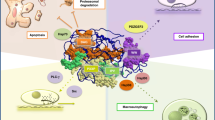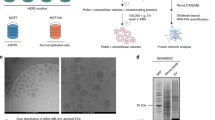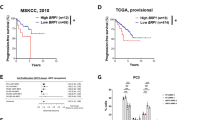Abstract
Germline mutations in BRCA1 are responsible for most cases of inherited breast and ovarian cancer. However, the function of the BRCA1 protein has remained elusive. We now show that BRCA1 encodes a 190-kD protein with sequence homology and biochemical analogy to the granin protein family. Interestingly, BRCA2 also includes a motif similar to the granin consensus at the C terminus of the protein. Both BRCA1 and the granins localize to secretory vesicles, are secreted by a regulated pathway, are post-translationally glycosylated and are responsive to hormones. As a regulated secretory protein, BRCA1 appears to function by a mechanism not previously described for tumour suppressor gene products.
This is a preview of subscription content, access via your institution
Access options
Subscribe to this journal
Receive 12 print issues and online access
$209.00 per year
only $17.42 per issue
Buy this article
- Purchase on Springer Link
- Instant access to full article PDF
Prices may be subject to local taxes which are calculated during checkout
Similar content being viewed by others
References
Hall, J.M. et al. Linkage of early-onset breast cancer to chromosome 17q21. Science. 250, 1684–1689 (1990).
Miki, Y. et al. A strong candidate for the breast and ovarian cancer susceptibility gene BRCA1. Science. 266, 66–71 (1994).
Marquis, S.T. et al. The developmental pattern of Brca1 expression implies a role in differentiation of the breast and other tissues. Nature Genet. 11, 17–26 (1995).
Lane, T.F. et al. Expression of Brcal is associated with terminal differentiation of ectodermally and mesodermally derived tissues in mice. Genes Dev. 9, 2712–2722 (1995).
Gudas, J., HM Li, T. & Cowan, K.H. Hormone-dependent regulation of BRCA1 in human breast cancer cells. Cancer Res. 55, 4561–4565 (1995).
Gorr, S.-U., Shioi, J. & Cohn, D.V. Interaction of calcium with porcine adrenal chromogranin A (secretory protein I) and chromogranin B (secretogranin I). Am. J. Physiol. 257, E247–E254 (1989).
Thompson, M.E., Zimmer, W., EM Haynes, A.L., Valentine, D.L., Forss-Petter, s., and Scamme, J.G. Prolactin granulogenesis is associated with increased secretogranin expression and aggregation in the golgi apparatus of GH4C1 cells. Endocrinol. 131, 318–326 (1992).
Huttner, W.B., Gerdes, H.-H. & Rosa, P. The granin (chromogranin/ secretogranin) family. Trends Biochem. Sci. 16, 27–30 (1991).
Konecki, D.S., Benedum, U.M., Gerdes, H.-H. & Huttner, W.B. The primary structure of human chromogranin A and pancreastatin. J. Biol. Chem. 262, 17026–17030 (1987).
Fasciotto, B.H., Gorr, S.U., DeFranco, K.J., Levine, M.A. & Cohn, D.V. Pancreastatin, a presumed product of chromogranin A (secretory protein I)processing, inhibits secretion from porcine parathyroid cells in culture. Endocrinol. 125, 1617–1622 (1989).
Stampfer, M., Hallowes, R.C. & Hackett, A.J. Growth of normal human mammary cells in culture. In Vitro 16, 415–425 (1980).
Chen, Y. et al. Aberrant subcellular localization of BRCA1 in breast cancer. Science 270, 789–791 (1995).
Holt, J.T. et al. Growth retardation and tumour inhibition by BRCA1. Nature Genet. 12, 298–302 (1996).
Fischer-Colbrie, R. et al. Sex-related differences in chromogranin A, chromogranin B and secretogranin II gene expression in rat pituitary. J. Neuroendocrinol. 121, 125–130 (1991).
Wooster, R. et al. Identification of the breast cancer susceptibility gene BRCA2. Nature 379, 789–792 (1995).
Gaffney, E.V. A cell line (HBL-100) established from breast milk. Cell Tissue Res. 227, 563–568 (1982).
Jensen, R.A., Beeler, J.F., Heidaran, M.A. & LaRochelle, W.J. Purification and characterization of baculovirus-expressed human α and β platelet-derived growth factor receptors. Biochem. 31, 10887–10892 (1992).
Fazioli, R., Minchiello, L., Matoskova, B., Wong, W.T. & Di Fiore, P.P. epsl 5, a novel tyrosine kinase substrate, exhibits transforming activity. Mol. Cell. Biol. 13, 5814–5828 (1993).
Tooze, S.A. & Huttner, W.B. Cell-free protein sorting to the regulated and constitutive secretory pathways. Cell 60, 837–847 (1990).
Jetton, T.L. et al. Analysis of upstream glucokinase promoter activity in transgenic mice and identification of glucokinase in rare neuroendocrine cells in the brain and gut. J. Biol. Chem. 269, 3641–3654 (1994).
Author information
Authors and Affiliations
Rights and permissions
About this article
Cite this article
Jensen, R., Thompson, M., Jetton, T. et al. BRCA1 is secreted and exhibits properties of a granin. Nat Genet 12, 303–308 (1996). https://doi.org/10.1038/ng0396-303
Received:
Accepted:
Issue Date:
DOI: https://doi.org/10.1038/ng0396-303
This article is cited by
-
Novel mutations in the RING-finger domain of BRCA1 gene in clinically diagnosed breast cancer patients
3 Biotech (2020)
-
BRCA1 alterations are associated with endometriosis, but BRCA2 alterations show no detectable endometriosis risk: a study in Indian population
Journal of Assisted Reproduction and Genetics (2015)
-
BRCA1 and EGFR as prognostic biomarkers in triple negative metastatic breast cancer patients treated with cisplatin plus docetaxel
The Chinese-German Journal of Clinical Oncology (2010)
-
Analysis of Loss of heterozygosity and immunohistochemistry in BRCA1 gene in sporadic breast cancers
Molecular and Cellular Biochemistry (2006)
-
A role for BRCA1 in sporadic breast cancer
British Journal of Cancer (2003)



